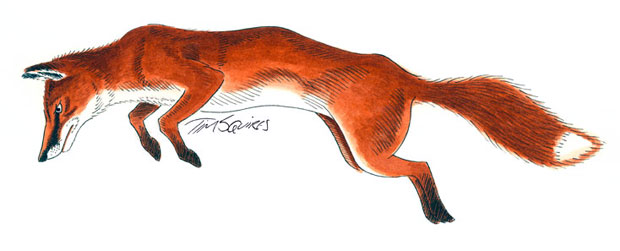 Tasmanians might make jokes about elusive foxes in the state – mainly about the cost of the $50-million fox eradication program that never seems to turn one up – but in Britain they are no laughing matter.
Tasmanians might make jokes about elusive foxes in the state – mainly about the cost of the $50-million fox eradication program that never seems to turn one up – but in Britain they are no laughing matter.
The urban fox has taken hold in London to a remarkable degree and day after day they demonstrate why they are impossible to eradicate once they establish a presence. The urban foxes are plundering not only wildlife in city parks but taking domestic animals like cats. The London Wetlands Centre, the biggest urban reserve in Europe situated on the Thames at Hammersmith, has had to erect fox-proof fences to protect species of wildfowl that have returned to the city for the first time in hundreds of years.
The European fox is one of the most cunning, relentless and dextrous animals known to nature and seems capable of outwitting a creature of allegedly superior intelligence, Homo sapiens, at every turn.
During a holiday in Britain earlier this year I stayed with friends in an inner city London area and was amazed to see foxes prowling the streets at all times of the day.
Foxes are not new to me. I grew up in semi-rural Surrey to the west of London and frequently saw foxes, although in those days you had to go in search of them, driving country lanes at night in the hope of surprising one on roadkill.
But during the 16 years I have lived in Australia the fox has increasingly left rural areas and moved into the British cities. The reason for this change in distribution is complex but the industrialisation of farming has been a factor. This has seen traditional hiding places in hedgerows bulldozed, and a decline in bird and smaller mammal species which have in the past formed the fox’s prey.
Farmland bird species, for example, have declined by nearly 50 per cent since the 1970s.
The intelligence of the fox, Raynard in folklore, is legendary and this added to the thrill of the chase when fox hunting was still legal in Britain. It took a skilled hunt master and his dogs to outfox the fox, although the odds were evened up somewhat by the covering up of known fox holes before the chase.
Although I had hopes of seeing foxes in their natural environment during my stay in Britain, I had not been prepared for the urban ones, with appeared mangy and scruffy and so different to the sleek red-furred animals of my youth.
The urban fox, however, has not lost any of its skills. I had read of foxes climbing trees to avoid the hunt, and crossing frozen lakes which could not take the weight of a pack of hounds and horses, and here in urban London I saw foxes climbing fences and scrambling onto the roofs of outhouses so they could catch the warm rays of the winter sun.
I also noticed an absence of cats prowling neighbouring gardens and was told that these often fall prey to hungry foxes.
Cities can afford to lose a few cats, but it is in the countryside of foreign lands where foxes have been introduced – like Australia- that their real menace becomes apparent.
I have written in the past that much of Tasmania’s unique wildlife would vanish if the fox took hold here. These creatures include the already endangered Tasmanian devil, which would lose young to foxes, and endemic bird species like the flightless Tasmanian native-hen.
Without entering the debate about what is appropriate funding for fox eradication, to take the eye off the ball would have potentially devastating effects on both wildlife tourism and farming in Tasmania, to say nothing of the birds and animals, both wild and domesticated, themselves.